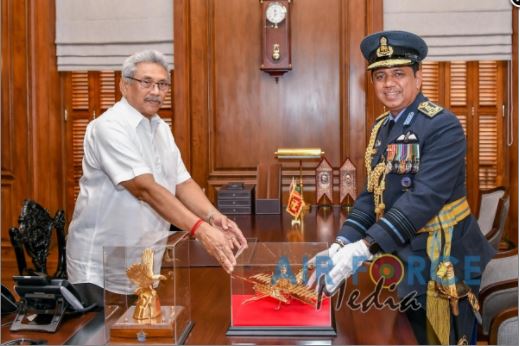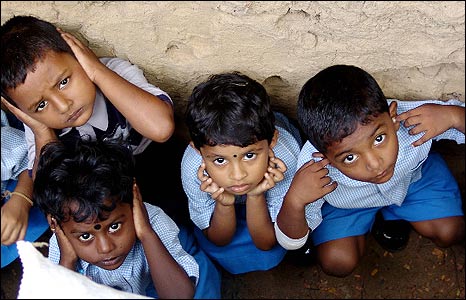
Despite ongoing human rights abuses, the Sri Lankan Air Force (SLAF) will receive two military aircraft from the United States at no cost through a Foreign Military Sales contract, following a request made by the commander of the Sri Lankan airforce.
The delivery of planes which is said to be completed by 2022 to 2023, was made based on the request from the Commander of the Sri Lankan Air Force, Sudarshana Pathirana according to a report in the Daily Mirror.
Pathirana joined the SLAF in 1985, and was a part of the first batch of pilots to fly supersonic jets in Sri Lanka. He then went on to command the No 5 Fighter squadron and the infamous No 10 Fighter squadron, which was formed in 1996 and consisted of Kfir jets. Pathirana frequently flew Kfir C2 / C7, the jets were synonymous with the targeting of Tamil civilians and non-military targets and with Pathirana accumulating more than 3,500 flying hours, he would have likely participated in the bombing raids.
Tamil activists have labelled many of those attacks war crimes.

Accused war criminals Gotabaya Rajapaksa (L) Sudarshana Pathirana (R)
Textron Aviation which has been awarded a USD $11 million contract by the US government will produce two Beechcraft King Air 360ER to replace an earlier model used by the SLAF.
The plane which is used for maritime surveillance is said to assist the Sri Lankan Navy in combating "transnational crimes including human smuggling as well as drug trafficking", the DailyMirror reports. Since the end of the armed conflict drug use has become rampant across the North-East. In increasingly frequent cases, police officers have been linked to the narcotics trade, with former politicians claiming a drug kingpin was murdered to protect the identity of 80 politicians complicit in drug trafficking. Despite the heavy militarisation of the North-East, it has become apparent that drug use is becoming more frequent, with civil society groups claiming that the rise in drugs across the North-East is being facilitated by the Sri Lankan state.
A history of massacres

File photograph: Tamil children shelter in a bunker during a Sri Lankan airstrike
Kfir jets, the types that were flown by Pathirana have been extensively used by the Sri Lankan Air Force to carry out bombing raids across the North-East, and have killed thousands of Tamils throughout the years.
Sri Lanka first purchased the Kfir jets from Israel in 1996, by which time the jet had been withdrawn from the Israeli Air Force but was being exported internationally. A new unit was formed – the No. 10 Fighter Squadron – based at the SLAF barracks in Katunayake, adjacent to the island’s international airport, just 25 minutes flying time from the North-East.
The six newly purchased jets were immediately put to use by the military, as it began to extensively bomb the Tamil homeland, causing massive loss of life and widespread destruction. The use of the aircraft became so prevalent that for Tamils the name Kfir, Hebrew for "Lion Cub", became synonymous with all the aircraft used by the Sri Lankan military during attacks on the Tamil homeland.
In one notorious massacre in 1999, more than 21 Tamil civilians were killed in a Kfir bombing on a crowded market in Puthukkudiyiruppu. See the names of some of those killed here.
Kfir strikes ramp up

File photograph: Tamil schoolchildren shelter in a bunker during a Sri Lankan air raid
With the Sri Lankan military offensive gaining momentum, airstrikes in particular began to ramp up.
On August 14 2006, Sri Lanka launched one its deadliest Kfir attacks. Four jets flew over the Vanni and dropped sixteen bombs over the Sencholai children's home for orphans, killing 53 school girls and 3 teachers.
The children's home had been designated a humanitarian zone and its GPS coordinates had been passed to the Sri Lankan military via the UN children’s agency, UNICEF, and the International Committee for the Red Cross (ICRC). A survivor of the attack, Paranthan Hindu Mahavidyalam student Mary Arulappan Juliet, recalled the horror of the massacre, in an interview just days later.
“It was 7 a.m., we were by the compound well, when we saw the Kfir jets far-away and thought that they heading to the battle theater elsewhere,” she said. “Within a seconds we saw them heading directly to our centre and suddenly started bombing our premises.”
"As the bombs fell, the girls ran in all directions, and took cover by lying on the ground face down, hoping that the bombers will go away after attacking once. But the Kfir jets returned firing additional munitions directed to our facility," Juliet added. "There was chaos within the Sencholai premises with each round of bombing, as more students were getting wounded severely and getting killed. In between air strikes, the girls changed their cover locations by running to other positions to take better cover".
"In the aerial strikes, many died on the spot, and many were wounded, most had multiple injuries, some lost their limbs, some had severe burns. All the girls were pleading for help, pleading to be taken to a hospital."

Read more about the massacre here: Remembering the Sencholai massacre 14 years on
Read more here: Bringing back Kfirs - Sri Lanka’s infamous warplanes to get US$50 million revamp
Read more at the Daily Mirror and Newswire.
